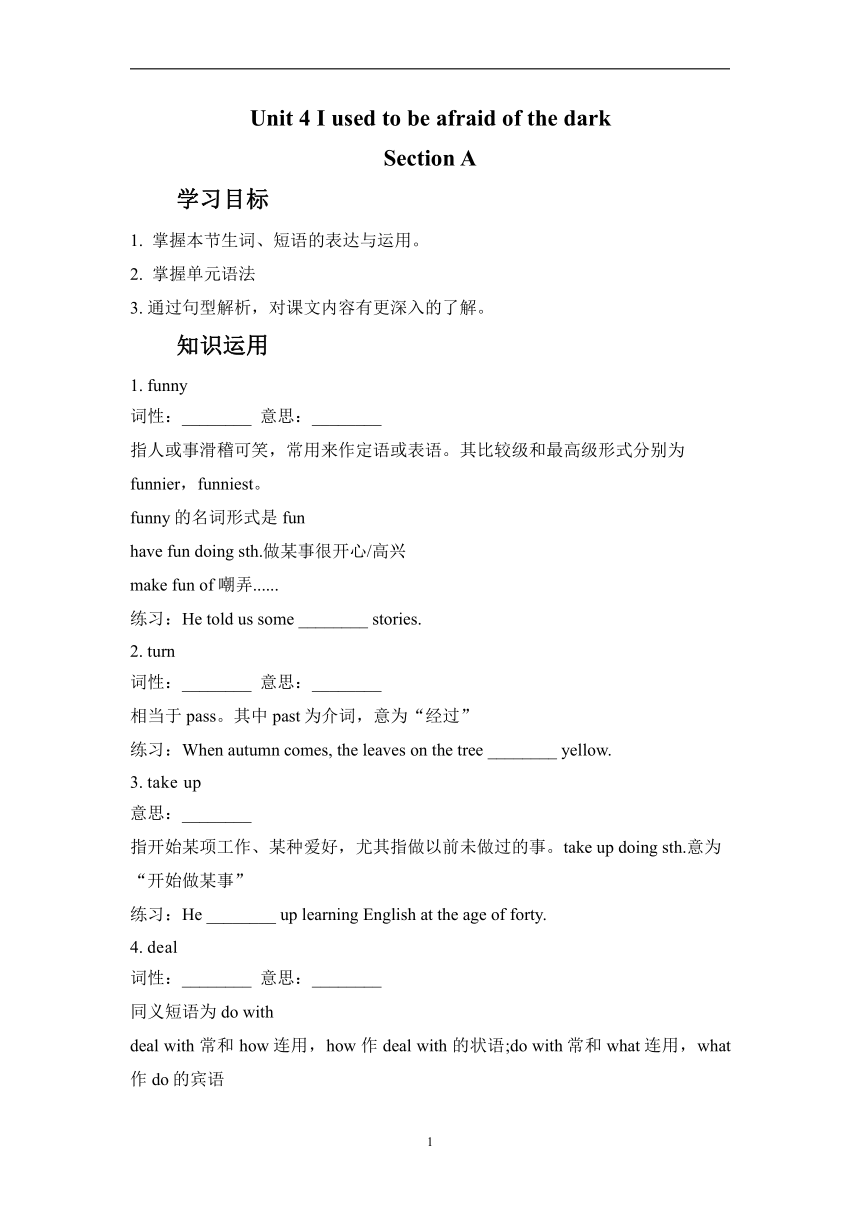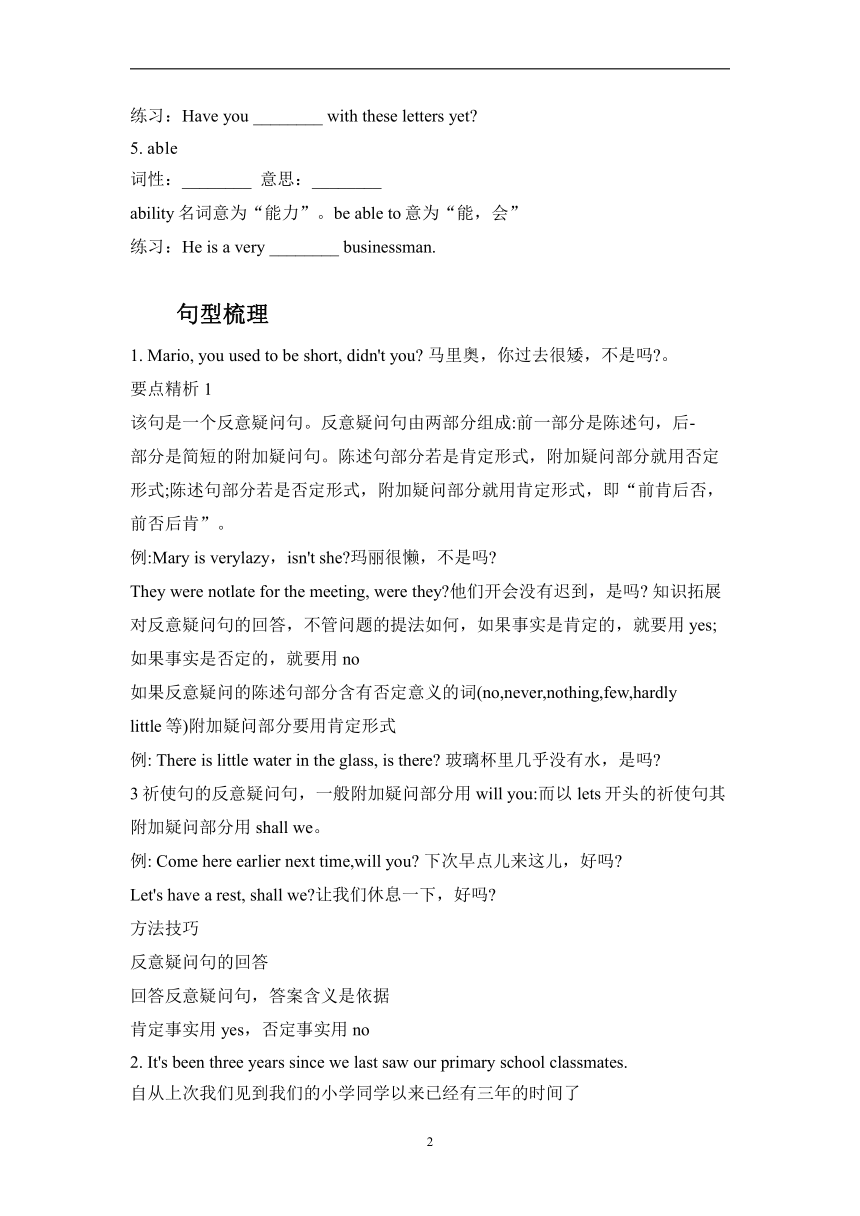Unit 4 I used to be afraid of the dark Section A 学案 (含解析)
文档属性
| 名称 | Unit 4 I used to be afraid of the dark Section A 学案 (含解析) |  | |
| 格式 | docx | ||
| 文件大小 | 27.8KB | ||
| 资源类型 | 教案 | ||
| 版本资源 | 人教新目标(Go for it)版 | ||
| 科目 | 英语 | ||
| 更新时间 | 2023-11-10 13:14:20 | ||
图片预览


文档简介
Unit 4 I used to be afraid of the dark
Section A
学习目标
掌握本节生词、短语的表达与运用。
掌握单元语法
3. 通过句型解析,对课文内容有更深入的了解。
知识运用
1. funny
词性:________ 意思:________
指人或事滑稽可笑,常用来作定语或表语。其比较级和最高级形式分别为funnier,funniest。
funny的名词形式是fun
have fun doing sth.做某事很开心/高兴
make fun of 嘲弄......
练习:He told us some ________ stories.
2. turn
词性:________ 意思:________
相当于pass。其中 past为介词,意为“经过”
练习:When autumn comes, the leaves on the tree ________ yellow.
3. take up
意思:________
指开始某项工作、某种爱好,尤其指做以前未做过的事。take up doing sth.意为“开始做某事”
练习:He ________ up learning English at the age of forty.
4. deal
词性:________ 意思:________
同义短语为do with
deal with 常和 how连用,how 作deal with 的状语;do with常和what连用,what作do的宾语
练习:Have you ________ with these letters yet
5. able
词性:________ 意思:________
ability名词意为“能力”。be able to意为“能,会”
练习:He is a very ________ businessman.
句型梳理
1. Mario, you used to be short, didn't you 马里奥,你过去很矮,不是吗 。
要点精析 1
该句是一个反意疑问句。反意疑问句由两部分组成:前一部分是陈述句,后-
部分是简短的附加疑问句。陈述句部分若是肯定形式,附加疑问部分就用否定
形式;陈述句部分若是否定形式,附加疑问部分就用肯定形式,即“前肯后否,前否后肯”。
例:Mary is verylazy,isn't she 玛丽很懒,不是吗
They were notlate for the meeting, were they 他们开会没有迟到,是吗 知识拓展
对反意疑问句的回答,不管问题的提法如何,如果事实是肯定的,就要用yes;如果事实是否定的,就要用no
如果反意疑问的陈述句部分含有否定意义的词(no,never,nothing,few,hardly
little等)附加疑问部分要用肯定形式
例: There is little water in the glass, is there 玻璃杯里几乎没有水,是吗
3祈使句的反意疑问句,一般附加疑问部分用will you:而以lets开头的祈使句其
附加疑问部分用shall we。
例: Come here earlier next time,will you 下次早点儿来这儿,好吗
Let's have a rest, shall we 让我们休息一下,好吗
方法技巧
反意疑问句的回答
回答反意疑问句,答案含义是依据
肯定事实用yes,否定事实用no
2. It's been three years since we last saw our primary school classmates.
自从上次我们见到我们的小学同学以来已经有三年的时间了
要点精析 1
“It'sbeen+一段时间+since+从句”意为“自从......以来已经有多长时间了”还可
表示为“Itis+一段时间+ since+从句”。
例: It has been five years since I began to learn English. =It's five years since I
began tolearn English.自从我开始学英语已经有5年的时间了
要点精析 2
此句为现在完成时的句子。现在完成时常与 since引导的以某一时间为起点的时间状语或 for引导的一段时间连用,谓语动词要用延续性动词
例:She has lived in Beijing since 1998.她从1998年起就住在北京
We have known each other for five years.我们已经认识彼此5年了。
3. Now she's not shy anymore and loves singing in front of crowds.现在她不再害羞,并且喜欢在观众面前唱歌
要点精析
not...anymore 意为“不再......”,其同义短语有 no more,not...any
longer, no longer.
例:He isn't a teacher anymore.他不再是一位老师了
辨析 not...any more 与 not...any longer
not...any more(=no more) 多指数量和程度上“不再”常修饰非延续性动词。常
用于将来时态
not...any longer(=no longer)表示时间上或距离的“不再”,常修饰延续性动词
常用于现在时态
例: He will no more go there.他将不再去那里了
We don't live here any longer.=We no longer live here.我们不再在这里了。
语法讲解
used to的用法
构成:used to+动词原形
He used to play basketball afterschool.他过去常常放学后打篮球。
用法: 表示过去的习惯动作或状态,现在已不再发生或不存在。其中 to为不定式,后接动词原形。
He used to be a very poor man.他过去是一个很穷的人。(暗指现在已经不穷了)
句型变化
否定句:used not to, usedn't to或 didn't use to
She didn't use to have long hair.=She usedn't to have long hair她过去不留长发。
一般疑问句: Did sb.use to... /Used sb.to...
Did you use to play the piano =Used you to play the piano 你过去常常弹钢琴吗
反意疑附加疑:附加疑问部分可用didn't或 usedn't
He didn't use to drink, did he 他过去不常喝酒,对吗
He used to drink, usedn't he 他过去常常喝酒,对吗
相似短语
be /get/ become used to doing sth. 意为“习惯做某事”
My grandfather is used to going for a walk after dinner我爷爷习惯晚饭后去散步
be used to do sth.意为“被用来做……”
Wood can be used to make paper木头能被用来造纸
练习:
单项选择
( )1. LiMing used_______on the right in China, but he soon got used_______on the left in England.
A to drive; to drive
C. to driving; to drive
B. driving: driving
D. to drive; to driving
( )2. This sign is used_______ tourists to stay away from the lion in the zoo.
A.to warn B.to warning C. to make D. to making
( )3. She used to _______ in the morning, but now she is used to at night.
A. read; read B. read: reading C. reading; read D. reading; reading
( )4. Jeremy Lin _______an unknown basketball player in New York Knicks for quite a
long time
A. used to be .B used to being C. is used to be D. was used to be
( )5. The young man used to _______ to work, but he is used to to work now.
A drive; walking B.drove; walked C. drive; walks D.driving; walk
答案
知识运用
funny 2. turn 3. took up 4. dealt 5. able
语法精讲
1.D句意:李明过去在中国靠右边驾驶,但是他在英国很快就习惯靠左边驾驶。表示“过去常常做某事”用used to do sth,表示 “习惯做某事”用get used to doing sth.故选D。
2.A意这个标志被用来警告游客远离动物园里的狮子。表示“被用来做某事”用be used to do sth故选A.
3B第空考查used to do sth表示“过去常常做某事”;第二空考查be used to doing sth.,表示“习惯做某事”。句意:她过去常常在早上看书,但是现在她习惯在
晚上看书。
4A由意“林书豪在过去相当长的一段时间内是纽约尼克斯队一个知名度不高的篮球运动员。可知,表示"过去常常是......"用used to be...
5.A used to意为“过去常常“后面接动词原形先排除BD两项;be used to doing
sth.意为“习惯做某事”其中to是介词,后面接动名词,故选A。
2
Section A
学习目标
掌握本节生词、短语的表达与运用。
掌握单元语法
3. 通过句型解析,对课文内容有更深入的了解。
知识运用
1. funny
词性:________ 意思:________
指人或事滑稽可笑,常用来作定语或表语。其比较级和最高级形式分别为funnier,funniest。
funny的名词形式是fun
have fun doing sth.做某事很开心/高兴
make fun of 嘲弄......
练习:He told us some ________ stories.
2. turn
词性:________ 意思:________
相当于pass。其中 past为介词,意为“经过”
练习:When autumn comes, the leaves on the tree ________ yellow.
3. take up
意思:________
指开始某项工作、某种爱好,尤其指做以前未做过的事。take up doing sth.意为“开始做某事”
练习:He ________ up learning English at the age of forty.
4. deal
词性:________ 意思:________
同义短语为do with
deal with 常和 how连用,how 作deal with 的状语;do with常和what连用,what作do的宾语
练习:Have you ________ with these letters yet
5. able
词性:________ 意思:________
ability名词意为“能力”。be able to意为“能,会”
练习:He is a very ________ businessman.
句型梳理
1. Mario, you used to be short, didn't you 马里奥,你过去很矮,不是吗 。
要点精析 1
该句是一个反意疑问句。反意疑问句由两部分组成:前一部分是陈述句,后-
部分是简短的附加疑问句。陈述句部分若是肯定形式,附加疑问部分就用否定
形式;陈述句部分若是否定形式,附加疑问部分就用肯定形式,即“前肯后否,前否后肯”。
例:Mary is verylazy,isn't she 玛丽很懒,不是吗
They were notlate for the meeting, were they 他们开会没有迟到,是吗 知识拓展
对反意疑问句的回答,不管问题的提法如何,如果事实是肯定的,就要用yes;如果事实是否定的,就要用no
如果反意疑问的陈述句部分含有否定意义的词(no,never,nothing,few,hardly
little等)附加疑问部分要用肯定形式
例: There is little water in the glass, is there 玻璃杯里几乎没有水,是吗
3祈使句的反意疑问句,一般附加疑问部分用will you:而以lets开头的祈使句其
附加疑问部分用shall we。
例: Come here earlier next time,will you 下次早点儿来这儿,好吗
Let's have a rest, shall we 让我们休息一下,好吗
方法技巧
反意疑问句的回答
回答反意疑问句,答案含义是依据
肯定事实用yes,否定事实用no
2. It's been three years since we last saw our primary school classmates.
自从上次我们见到我们的小学同学以来已经有三年的时间了
要点精析 1
“It'sbeen+一段时间+since+从句”意为“自从......以来已经有多长时间了”还可
表示为“Itis+一段时间+ since+从句”。
例: It has been five years since I began to learn English. =It's five years since I
began tolearn English.自从我开始学英语已经有5年的时间了
要点精析 2
此句为现在完成时的句子。现在完成时常与 since引导的以某一时间为起点的时间状语或 for引导的一段时间连用,谓语动词要用延续性动词
例:She has lived in Beijing since 1998.她从1998年起就住在北京
We have known each other for five years.我们已经认识彼此5年了。
3. Now she's not shy anymore and loves singing in front of crowds.现在她不再害羞,并且喜欢在观众面前唱歌
要点精析
not...anymore 意为“不再......”,其同义短语有 no more,not...any
longer, no longer.
例:He isn't a teacher anymore.他不再是一位老师了
辨析 not...any more 与 not...any longer
not...any more(=no more) 多指数量和程度上“不再”常修饰非延续性动词。常
用于将来时态
not...any longer(=no longer)表示时间上或距离的“不再”,常修饰延续性动词
常用于现在时态
例: He will no more go there.他将不再去那里了
We don't live here any longer.=We no longer live here.我们不再在这里了。
语法讲解
used to的用法
构成:used to+动词原形
He used to play basketball afterschool.他过去常常放学后打篮球。
用法: 表示过去的习惯动作或状态,现在已不再发生或不存在。其中 to为不定式,后接动词原形。
He used to be a very poor man.他过去是一个很穷的人。(暗指现在已经不穷了)
句型变化
否定句:used not to, usedn't to或 didn't use to
She didn't use to have long hair.=She usedn't to have long hair她过去不留长发。
一般疑问句: Did sb.use to... /Used sb.to...
Did you use to play the piano =Used you to play the piano 你过去常常弹钢琴吗
反意疑附加疑:附加疑问部分可用didn't或 usedn't
He didn't use to drink, did he 他过去不常喝酒,对吗
He used to drink, usedn't he 他过去常常喝酒,对吗
相似短语
be /get/ become used to doing sth. 意为“习惯做某事”
My grandfather is used to going for a walk after dinner我爷爷习惯晚饭后去散步
be used to do sth.意为“被用来做……”
Wood can be used to make paper木头能被用来造纸
练习:
单项选择
( )1. LiMing used_______on the right in China, but he soon got used_______on the left in England.
A to drive; to drive
C. to driving; to drive
B. driving: driving
D. to drive; to driving
( )2. This sign is used_______ tourists to stay away from the lion in the zoo.
A.to warn B.to warning C. to make D. to making
( )3. She used to _______ in the morning, but now she is used to at night.
A. read; read B. read: reading C. reading; read D. reading; reading
( )4. Jeremy Lin _______an unknown basketball player in New York Knicks for quite a
long time
A. used to be .B used to being C. is used to be D. was used to be
( )5. The young man used to _______ to work, but he is used to to work now.
A drive; walking B.drove; walked C. drive; walks D.driving; walk
答案
知识运用
funny 2. turn 3. took up 4. dealt 5. able
语法精讲
1.D句意:李明过去在中国靠右边驾驶,但是他在英国很快就习惯靠左边驾驶。表示“过去常常做某事”用used to do sth,表示 “习惯做某事”用get used to doing sth.故选D。
2.A意这个标志被用来警告游客远离动物园里的狮子。表示“被用来做某事”用be used to do sth故选A.
3B第空考查used to do sth表示“过去常常做某事”;第二空考查be used to doing sth.,表示“习惯做某事”。句意:她过去常常在早上看书,但是现在她习惯在
晚上看书。
4A由意“林书豪在过去相当长的一段时间内是纽约尼克斯队一个知名度不高的篮球运动员。可知,表示"过去常常是......"用used to be...
5.A used to意为“过去常常“后面接动词原形先排除BD两项;be used to doing
sth.意为“习惯做某事”其中to是介词,后面接动名词,故选A。
2
同课章节目录
- Unit 1 How can we become good learners.
- Section A
- Section B
- Unit 2 I think that mooncakes are delicious!
- Section A
- Section B
- Unit 3 Could you please tell me where the restroom
- Section A
- Section B
- Unit 4 I used to be afraid of the dark.
- Section A
- Section B
- Unit 5 What are the shirts made of?
- Section A
- Section B
- Review of Units 1-5
- Unit 6 When was it invented?
- Section A
- Section B
- Unit 7 Teenagers should be allowed to choose their
- Section A
- Section B
- Unit 8 It must belong to Carla.
- Section A
- Section B
- Unit 9 I like music that I can dance to.
- Section A
- Section B
- Unit 10 You're supposed to shake hands.
- Section A
- Section B
- Review of Units 6-10
- Unit 11 Sad movies make me cry.
- Section A
- Section B
- Unit 12 Life is full of the unexpected
- Section A
- Section B
- Unit 13 We're trying to save the earth!
- Section A
- Section B
- Unit 14 I remember meeting all of you in Grade 7.
- Section A
- Section B
- Review of Units 11-14
